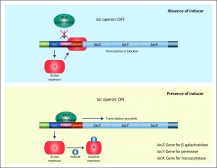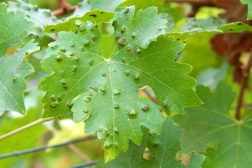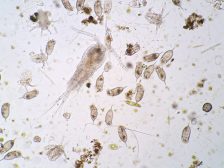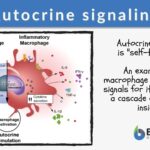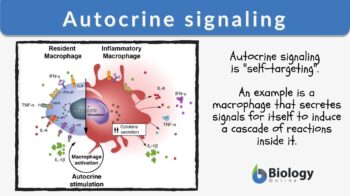
Autocrine signaling
n., [ˈɔːtəˌkrɪn ˈsɪɡnəlɪŋ]
Definition: ‘Auto’ refers to ‘self.’ Thus, “autocrine” implies “self-targeting”. Thus, it means a self-targeting type of cell signaling
Table of Contents
Autocrine Signaling Definition
What is autocrine signaling? Autocrine signaling is a type of cell signaling wherein a cell signal released from the cell binds to the same cell, i.e., ‘self‘. The chemical signal released from the cells is known as autocrine agents or autocrine signals.
Autocrine agents are the hormones or chemical signals that act as ligands and bind to the receptors present on the cells producing them. Such receptors are known as ‘autocrine receptors’. Once these autocrine agents bind to the receptors, i.e., autocrine stimulation, a chemical reaction is induced within the cell to bring about the necessary process. This is usually observed during early developmental stages wherein organ formation occurs and for pain sensation & inflammation regulation.
Autocrine signaling is also responsible for cells infected with viruses. Autocrine signaling also plays a vital role in cellular homeostasis. For example, progesterone has been found to act as an autocrine signal in breast cancer.
Autocrine signaling is a form of cell signaling in which the cell secretes an autocrine signal (e.g. hormone or chemical messenger) that binds to autocrine receptors on the same cell, leading to changes in the cell. Etymology: “autos”, meaning “self”. Compare: paracrine signaling
Cell signaling is the form of communication between cells. Cells communicate with each other through several cell signaling pathways. Cell signaling is necessary to make them aware of the neighboring cells and works according to these signals.
Depending upon the distance that cell signal needs to travel or cover to reach the receptor cell, the four major cell signaling pathways can be categorized into:
- Paracrine signaling
- Autocrine signaling
- Endocrine signaling
- Direct-contact signaling
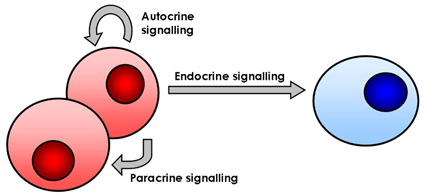
Paracrine signaling
In paracrine signaling, the cell signals travel a shorter distance to reach the receptors present on the neighboring cell surface. Essentially, two closely associated cells communicate via paracrine signaling. The signal diffuses out of the cell and travels through an extracellular matrix to reach the target cell. Synaptic signaling is a type of paracrine signaling wherein nerve cells communicate with each other at synapses through neurotransmitters (Figure 1).
Autocrine signaling
In biology, autocrine signaling is when the cell signals (hormones, cytokines, etc.) produced and released by the cell bind to the target receptors present on the same cell. This is the primary difference between autocrine and paracrine signaling. (Figure1)
Let us further understand the difference between paracrine signaling and autocrine signaling in depth.
Table 1: Differences between Paracrine signaling and autocrine signaling | |
|---|---|
| Table 1: Difference between Autocrine and Paracrine signaling | |
| Autocrine signaling | Paracrine signaling |
| Define autocrine signaling: It refers to self-targeting, i.e., the cell signals produced by the cells bind to the receptors of the same cells | Define paracrine signaling: Paracrine signaling is between cells that are closely associated or in the vicinity. |
Autocrine hormones or Cell signals:
| Cell signals:
|
| Target cells are the signal-producing cells | Target cells are the neighboring cells |
| Cell differentiation during early organ development in the embryonic stage | Neurotransmitters signaling through synapses. |
| Autocrine communication is the self-communication in the autocrine cells, i.e., with itself. | Paracrine communication is cell-to-cell communication with adjacent cells. |
|
|
Notable similarities between Autocrine and Paracrine Signaling are:
- Both are cell signaling pathway
- Small protein molecules serve as chemical signals for communication between two cells.
Interestingly, certain glands work both by paracrine as well as autocrine system. For example, the pituitary gland is one such endocrine, paracrine, and autocrine gland. Similarly, mammary glands work by both the paracrine and autocrine systems. (Autocrine glands are the glands that produce hormones that act on their own glandular cells, e.g., prostaglandins. In contrast, paracrine glands are those whose hormones are released into the extracellular matrix and reach the adjacent cells via diffusion, e.g., islets of Langerhans – somatostatin).
Endocrine signaling
Endocrine signaling is long-distance cell signaling. The signals travel to distant cells through the circulatory system, i.e. blood. Specialized cells produce the chemicals that are released in the bloodstream. Through the circulatory system, these chemicals then reach the target cell receptors. Such signals or chemicals are known as hormones, and the tissues producing them are referred to as glands.

Direct contact signaling
Direct contact signaling, also referred to as cell-to-cell contact signaling, is when two cells communicate with each other through gap junctions or plasmodesmata in plant cells. These water-filled channels permit small molecules & ions to travel through them from one cell to the other. However, big molecules like DNA can’t travel through these tiny channels.
Watch the video below to learn the basics of cell signaling. You may also read our Homeostatic Mechanisms and Cellular Communication Tutorial.
Having known these four types, you should be able to identify autocrine signaling from the other types of cell signaling. Let’s now see concrete examples of autocrine signaling in the next section.
Examples of Autocrine Signaling
Autocrine signaling is a vital cell-to-cell communication pathway for multiple physiological as well pathophysiological processes. Some of the autocrine regulations are discussed briefly below.
Cardiac remodeling and heart failure
During cardiac remodeling and heart failure, autocrine signaling is engaged in pathophysiological mechanisms, i.e., hypertrophy, fibrosis, angiogenesis, cell survival, and inflammation. The autocrine signals involved in the cardiac remodeling are fibroblast growth factors 2, heparin-binding–epidermal growth factor, angiopoietin‐like protein 2, C‐type natriuretic peptide, adiponectin, F21, and 23, macrophage migration inhibitory factor, leptin, follistatin‐like 1, apelin, neuregulin 1, wingless‐type integration site family, vascular endothelial growth factor, member 1‐induced secreted protein‐1, transforming growth factor β, connective tissue growth factor, interleukin 11, and calcitonin gene-related peptide. Thus, the involvement of several autocrine signals is an attractive therapeutic target for cardiac protection.
Inflammation and cytokine release
Autocrine signaling is a vital cell communication pathway in macrophages of the immune system. Macrophase secretes cytokine Interleukin-1 (IL-1). The macrophages secreting IL-1 also possess the IL-1 receptors, and bound receptors induce the intracellular cascade for more IL-1. Thus, IL-1 secretion is mediated by autocrine signaling, forming a forward-feedback loop. In addition, an NF-κB signaling pathway is critical for the stimulation and maintenance of the cytokines in inflammation.
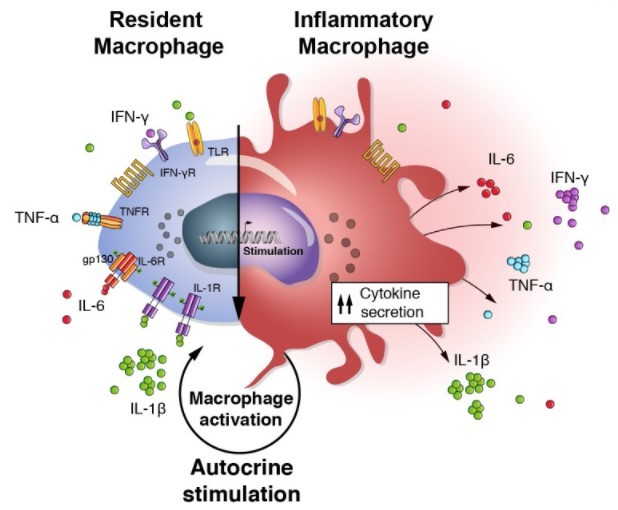
Cancer
The self-sustaining growth of cancer cells is attributed to autocrine signaling. An autocrine cell signaling-mediated proliferation is responsible for tumor formation and malignancy. Autocrine growth modulatory substances, i.e., growth factors, are involved in the uncontrolled growth of the cells that results in tumor or cancerous cell growth. Growth factors are the small polypeptides that stimulate and promote cell differentiation and cell division. Growth factors provide a first hallmark feature to the cancerous cell, i.e., self-sustainability and proliferation. These growth factors generally work through tyrosine kinase receptors.
Tyrosine kinase is a membrane-bound receptor, which is activated upon binding with the specific growth factors that initiate the growth cascade. Platelet-derived growth factor (PDGF), Human vascular endothelial growth factor (VEGF), Epidermal growth factor family (EGF), Fibroblast growth factor (FGF), Transforming growth factor-β family, Insulin-like growth factor (IGF), Hepatocyte growth factor (HGF) or Serum factor (SF), Neurotrophin, Ephrin, and Angiopoietins are some of the growth factors that are involved in the cancerous cell formation. Each growth factor serves a specific role in cancer cell generation.
PDGF act as a mitogen and chemoattractant for fibroblasts for the cancerous cells. PDGF further stimulates fibroblasts for collagen production required for remodeling of cells. PDGF is also responsible for metastasis, cell migration, and blood vessel formation.
VEGF and Angiopoietins assist in blood vessel formation to provide the necessary oxygen to the cancerous cells. Anticancer monoclonal antibodies like Rituximab, Trastuzumab, Cetuximab, and Bevacizumab inhibit VEGF, thereby targeting cancer cell growth.
EGF is one of the main autocrine growth factors for viral cell growth in tumors. Characteristically, elevated levels of FGF have been found in pancreatic cancer. IGF growth factor is required for the regulation of growth, metabolism, and survival of the cancerous cells. HGF regulates cell growth and death by regulating apoptosis, angiogenesis, organ development, and morphogenesis. Therefore, HGF is now considered to be an important target for anticancer therapy.

Role of autocrine signaling in chemo-drug resistance in cancer cells
The development of chemo-drug resistance in cancer cells is commonly seen. It is a major challenge for developing effective anticancer therapy. Research indicates the involvement of autocrine signaling for the development of the chemo-resistance. Autocrine signaling in association with paracrine signaling helps the cancer cell to evade drug-induced cell apoptosis. Autocrine signals like Substance P contribute to the enhancement of malignancy and drug resistance.
Elevated levels of serum IL-6 are a characteristic feature of cancer. It has been found that the autocrine signaling-mediated production of IL-6 is responsible for the chemo-drug resistance in cancer cells. Cancer cells that respond to the treatment of chemotherapeutic agents do not produce IL-6; however, drug-resistant cancer cells have been found to produce IL-6 characteristically.
IL-6 is an autocrine factor as well as a potent growth factor that induces the expression of the epithelial-mesenchyme (EMT) phenotype in breast cancer cells. IL-6 has also been found to promote malignancy. Breast cancer and lung cancer cells characteristically produce elevated levels of IL-6 by autocrine signaling. Il-6 plays the role of growth factor particularly in renal cell carcinoma, cervical carcinoma, myeloma/plasmacytoma, certain T- and B-cell lymphomas, and AIDS Kaposi’s sarcoma-derived cells.
Elevated levels of IL-6 resulted in the development of chemo-drug resistance due to induction of mdr1 gene expression and activation of the Cytidine-Cytidine-Adenosine-Adenosine-Thymidine (CCAAT) enhancer-binding protein transcription factors. Due to this reason, IL-6 is being exploited for its usage as a prognostic factor to determine the chemo-drug resistance in cancer patients. Interestingly, IL-6 has a pleiotropic effect and exhibits both tumor-promoting as well as tumor-inhibiting effects.
Further, after the withdrawal of chemotherapeutic agents in cancer, cytokines produced by the cancer cells, particularly in breast cancer cells, activate NF-κB and Wnt/β-catenin pathways. Activation of NF-κB and Wnt/β-catenin pathways further enhances the cytokine production by autocrine inflammatory forward-feedback loop resulting in the development of drug resistance. Notably, suppose the breast tumor sample exhibits a high expression level of IL8, CXCR1, CXCR2, and Wnt target genes. In that case, the patients show low survival rates and a shorter duration of disease-free survival.
Try to answer the quiz below to check what you have learned so far about autocrine signaling.
References
- Addeo A, Obeid M, &Friedlaender A. (2020). COVID-19 and lung cancer: risks, mechanisms and treatment interactions. Journal for Immunotherapy of Cancer, 8(1). DOI: 10.1136/jitc-2020-000892. PMID: 32434788; PMCID: PMC7246105.
- Cadamuro, M., Brivio, S., Spirli, C., Joplin, R. E., Strazzabosco, M., & Fabris, L. (2017). Autocrine and Paracrine Mechanisms Promoting Chemoresistance in Cholangiocarcinoma. International journal of molecular sciences, 18(1), 149. https://doi.org/10.3390/ijms18010149
- Conze, D., Weiss, L., Regen, P. S., Bhushan, A., Weaver, D., Johnson, P., & Rincón, M. (2001). Autocrine production of interleukin 6 causes multidrug resistance in breast cancer cells. Cancer Research, 61(24), 8851–8858.
- Jia, D., Li, L., Andrew, S., Allan, D., Li, X., Lee, J., Ji, G., Yao, Z., Gadde, S., Figeys, D., & Wang, L. (2017). An autocrine inflammatory forward-feedback loop after chemotherapy withdrawal facilitates the repopulation of drug-resistant breast cancer cells. Cell death & disease, 8(7), e2932. https://doi.org/10.1038/cddis.2017.319
- Segers, V., & De Keulenaer, G. W. (2021). Autocrine Signaling in Cardiac Remodeling: A Rich Source of Therapeutic Targets. Journal of the American Heart Association, 10(3), e019169. https://doi.org/10.1161/JAHA.120.019169
- Witsch, E., Sela, M., & Yarden, Y. (2010). Roles for growth factors in cancer progression. Physiology (Bethesda, Md.), 25(2), 85–101. https://doi.org/10.1152/physiol.00045.2009.
©BiologyOnline.com. Content provided and moderated by Biology Online Editors.




